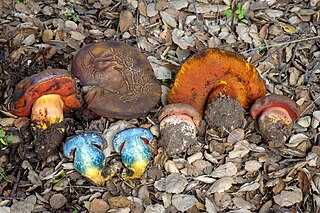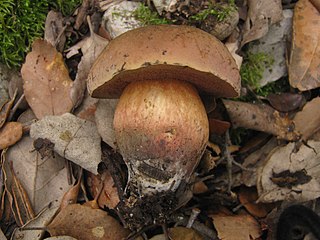
Caloboletus calopus, commonly known as the bitter beech bolete or scarlet-stemmed bolete, is a fungus of the bolete family, found in Asia, Northern Europe and North America. Appearing in coniferous and deciduous woodland in summer and autumn, the stout fruit bodies are attractively coloured, with a beige to olive cap up to 15 cm (6 in) across, yellow pores, and a reddish stipe up to 15 cm (6 in) long and 5 cm (2 in) wide. The pale yellow flesh stains blue when broken or bruised.

Neoboletus luridiformis, also previously known as Boletus luridiformis and (invalidly) as Boletus erythropus, is a fungus of the bolete family, all of which produce mushrooms with tubes and pores beneath their caps. It is found in Northern Europe and North America, and is commonly known as the scarletina bolete, for its red pores. Other common names is: red foot bolete, dotted stemmed bolete, dotted stem bolete.

Suillellus luridus, commonly known as the lurid bolete, is a fungus of the family Boletaceae, found in calcareous broadleaved woodlands in Europe. Fruit bodies appear in summer and autumn and may be locally abundant. It is a firm bolete with an olive-brown cap up to 20 cm (8 in) in diameter, with small orange or red pores on the underside. The stout ochre stem reaches 8–14 cm (3–6 in) high and 1–3 cm (0.4–1.2 in) wide, and is patterned with a red network. Like several other red-pored boletes, it stains blue when bruised or cut.

Exsudoporus frostii, commonly known as Frost's bolete or the apple bolete, is a bolete fungus first described scientifically in 1874. A member of the family Boletaceae, the mushrooms produced by the fungus have tubes and pores instead of gills on the underside of their caps. Exsudoporus frostii is distributed in the eastern United States from Maine to Georgia, and in the southwest from Arizona extending south to Mexico and Costa Rica. A mycorrhizal species, its fruit bodies are typically found growing near hardwood trees, especially oak.

Suillellus amygdalinus is a fungus of the bolete family found in western North America. The fruit bodies, or mushrooms, are characterized by their thick, red to brown caps, red pores, and the strong bluing reaction observed when the mushroom tissue is injured or cut. The cap can reach diameters of up to 12 cm (4.7 in) and the stipe 9 cm (3.5 in) long by 3 cm (1.2 in) thick at maturity. This mushroom has been found in manzanita and madrone woodlands of central California north to southern Oregon. Although the edibility of the mushroom is not known with certainty, it may be poisonous, and is not recommended for consumption. Other similar red-pored, bluing boletes from North America, including Rubroboletus eastwoodiae, Boletus luridiformis, and B. subvelutipes, can be distinguished from S. amygdalinus either by the color of the cap, the degree of reticulation on the stipe, or by location.

Suillellus queletii, commonly known as the deceiving bolete, is an uncommon, edible mushroom in the genus Suillellus.

Charles Christopher Frost was an American mycologist. He described several species of fungi from the New England area of the United States. In one paper, Frost described 22 new species of boletes, and he was later credited with the discovery of three additional species. His personal herbarium of specimens were given to the University of Vermont in 1902. Portions of his collection today are distributed between the Farlow Herbarium at Harvard University, the New York State Museum, the Bell Museum of Natural History, and the Buffalo Museum of Science.

Neoboletus pseudosulphureus is a species of bolete fungus in the family Boletaceae. It is found in Europe, Central America, North America, and India, where it grows in deciduous and mixed forests. Initially uniformly yellow in color, all external surfaces of the fruit body undergo a variety of discolorations as it matures.

Imperator torosus, commonly known as the brawny bolete, is a species of bolete fungus in the family Boletaceae. It is native to southern Europe east to the Caucasus and Israel. It is generally associated with deciduous trees such as hornbeam, oak and beech in warm, dry locales. Although generally rare in Europe, it appears to be relatively common in Hungary. Appearing in summer and autumn on chalky soils, the stocky fruit bodies have an ochre cap up to 20 cm (8 in) across, yellow pores on the cap underside, and a wine-red to brown or blackish stipe up to 6–15 cm (2.4–5.9 in) long by 3–6 cm (1.2–2.4 in) wide. The pale yellow flesh changes to different colours when broken or bruised depending on age; younger mushrooms become reddish, and older ones additionally take on bluish tones.
Carlo Luciano Alessio was an Italian mycologist. He was known for his expertise in the agaric genera Inocybe and Boletus.

Suillellus is a genus of bolete fungi in the family Boletaceae. It was originally described by William Alphonso Murrill in 1909 with Suillellus luridus as the type species. The genus was later sunk into synonymy with Boletus, but eventually resurrected in 2014, after molecular phylogenetics research demonstrated that Suillellus species comprised a different lineage than Boletus.
Suillellus adonis is a species of bolete fungus described from Croatia. Originally described as a species of Boletus in 2002, it was transferred to Suillellus in 2014, based on melacular phylogenetic data. This apparently rare fungus is so far known only from the islands of Cres and Cyprus.
Suillellus atlanticus is a species of bolete fungus found in coastal sand dunes in Galicia. Originally described as a species of Boletus in 2013, it was transferred to Suillellus the following year.

Suillellus comptus is a species of bolete fungus found in Europe. Originally described as a species of Boletus in 1993, it was transferred to Suillellus in 2014.
Suillellus hypocarycinus is a species of bolete fungus found in North America. Originally described as a species of Boletus by Rolf Singer in 1945, it was transferred to Suillellus by William Alphonso Murrill in 1948.

Suillellus mendax is a species of bolete fungus found in Europe. It was originally published as a species of Boletus when it was newly described in 2013, but then transferred to Suillellus the following year.
Rubroboletus pulchrotinctus is a rare bolete fungus in the genus Rubroboletus, native to central and southern Europe. It was originally described in genus Boletus by Italian mycologist Carlo Luciano Alessio in 1985, but subsequently transferred to genus Rubroboletus by Zhao and colleagues (2015), on the basis of molecular evidence. Phylogenetically, R. pulchrotinctus is the sister-species of the better known Rubroboletus satanas, with which it shares several morphological features.
Boletus gansuensis is a species of bolete fungus in the family Boletaceae. Found in China, where it grows in association with Himalayan birch, it was described as new to science in 2003. The fruitbodies of the fungus have red caps, pinkish-red pores on the cap underside, and a somewhat furfuraceous stipe. The specific epithet refers to the type locality in Gansu Province, China. Similar species include the European Suillellus queletii, and the North American and Asian Boletus subvelutipes.

Pulchroboletus is a fungal genus in the family Boletaceae. It was circumscribed in 2014 to contain the species formerly known as Xerocomus roseoalbidus, a rare bolete fungus originally described from Sardinia, Italy. Pulchroboletus roseoalbidus is found in Mediterranean Europe, where it grows in association with oak species and less often Cistus species. In 2017, the species Boletus rubricitrinus was moved to Pulchroboletus. Pulchroboletus rubricitrinus can be found under Quercus in lawns in Florida and Texas.












